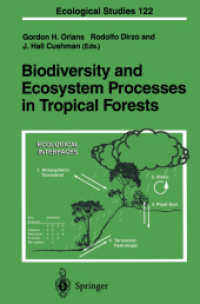- ホーム
- > 洋書
- > ドイツ書
- > Humanities, Arts & Music
- > Linguistics
- > general surveys & lexicons
基本説明
New in paperback. Hardcover was published in 2007. The volume has four parts: Part I (Language minorities and inequality) analyses language contact and linguistic diversity as a global phenomenon, Part II (Language planning and language change) focuses on colonialism, imperialism and economics as factors that language policies and planning measures must account for, Part III (Language variation and change in institutional contexts) examines language-related problems in educa-tion, religion, science and the Internet, and Part IV (The discourse of linguistic diversity and language change) relates public discourses on language and racism, sexism and political correctness to different ideological positions, values and attitudes.
Full Description
In line with the overall perspective of the Handbook series, the focus of Vol.9 is on language-related problems arising in the context of linguistic diversity and change, and the contributions Applied Linguistics can offer for solutions.
Part I, "Language minorities and inequality," presents situations of language contact and linguistic diversity as world-wide phenomena. The focus is on indigenous and immigrant linguistic minorities, their (lack of) access to linguistic rights through language policies and the impact on their linguistic future .Part II "Language planning and language change," focuses on the impact of colonialism, imperialism, globalisation and economics as factors that language policies and planning measures must account for in responding to problems deriving from language contact and linguistic diversity. Part III, "Language variation and change in institutional contexts," examines language-related problems in selected institutional areas of communication (education, the law, religion, science, the Internet) which will often derive from socioeconomic, cultural and other non-linguistic asymmetries. Part IV, "The discourse of linguistic diversity and language change," analyses linguistic diversity, language change and language reform as issues of public debates which are informed by different ideological positions, values and attitudes (e.g. with reference to sexism, racism, and political correctness).The volume also contains extensive reference sections and index material.






